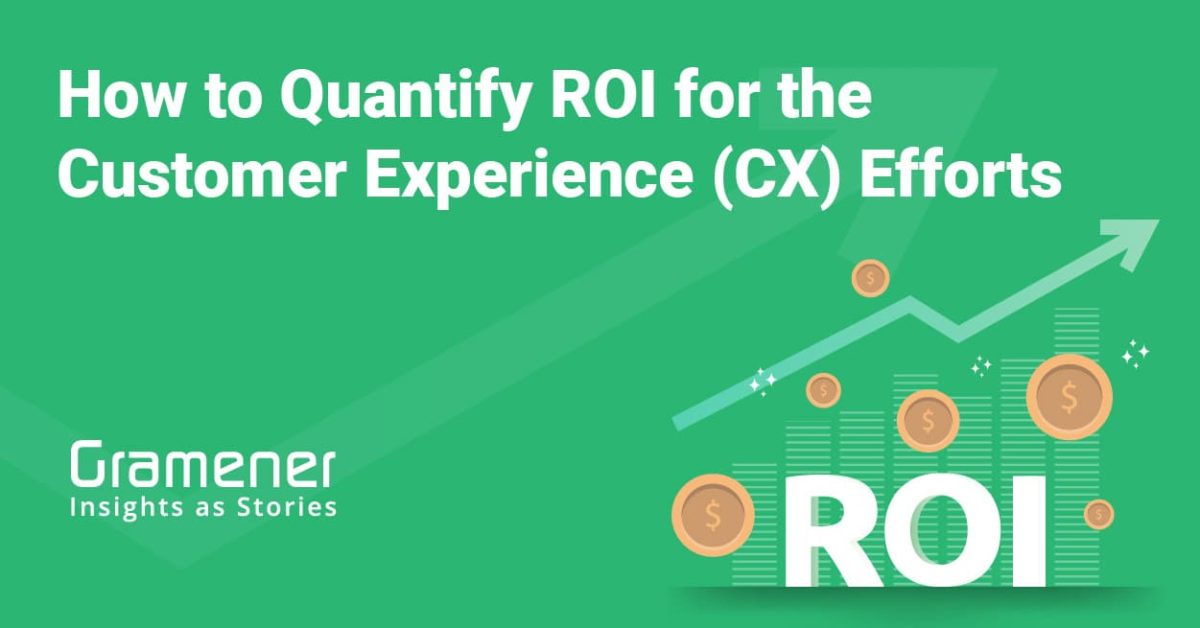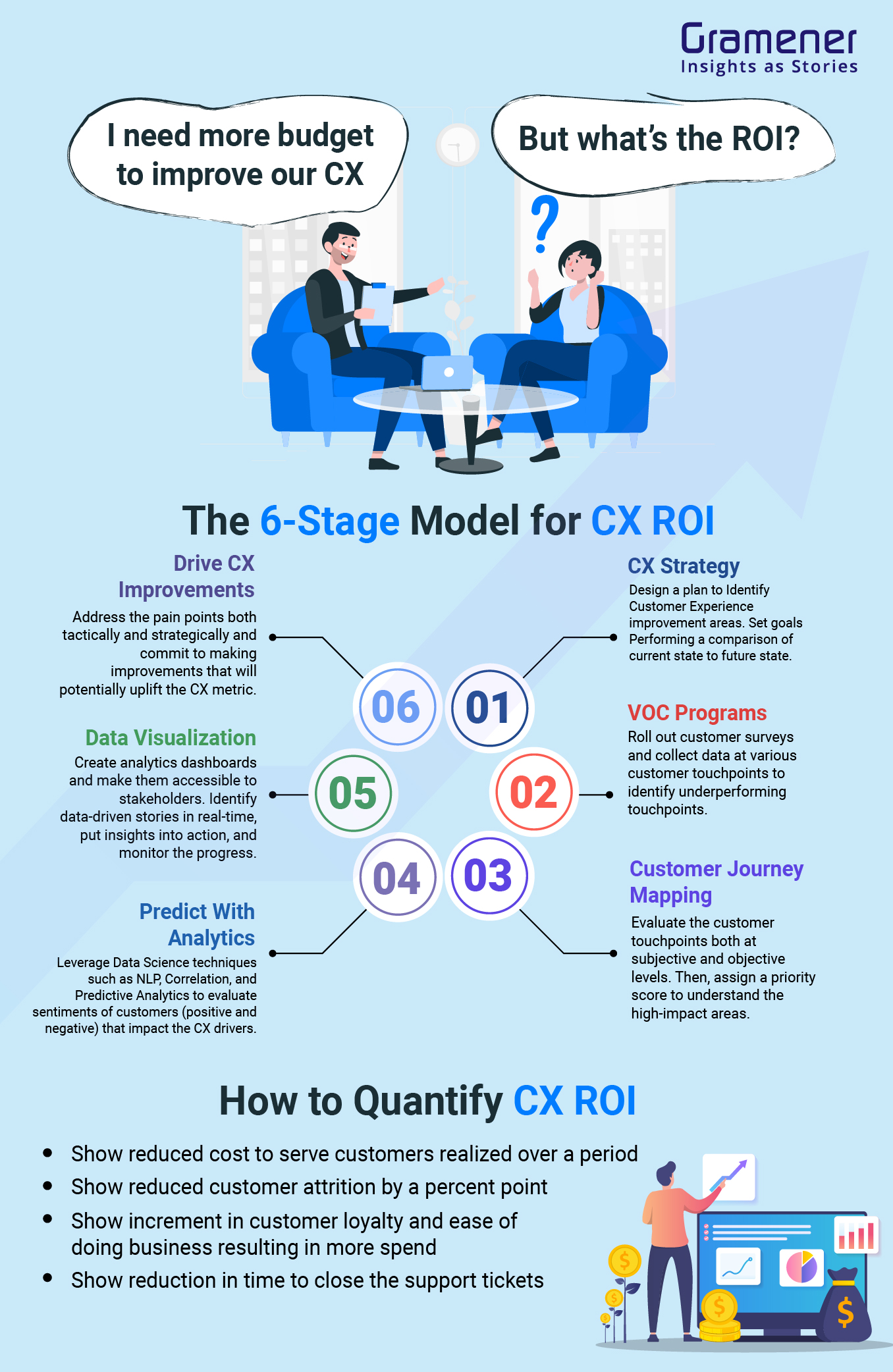Customer experience (CX) leaders often face hurdles in budget approval. The Customer Experience Return on Investment (CX ROI) is not quantitatively articulated. All the time and effort spent in designing a responsive customer experience program may not seem fruitful if you are not able to convey the value in numbers that it will bring to your organization.
In a recent customer journey management and CX measurement survey, almost one of the two CX leaders reported that they are not satisfied with their ability to quantify the impact of CX on business metrics and outcomes.
In order to put CX initiatives on a level footing with other business programs, it isn’t enough to provide the soft benefits. You should be able to quantitatively prove the ROI to make a strong business case and obtain approval for sustained investment and interest.
Read article: Find out why customer sentiment analysis is the key to measuring customer experience (CX).
6 Steps to Define and Calculate CX ROI
When calculating the costs of investments into CX, these are the typical areas companies invest into (not an exhaustive list):
Stage 1: Design the CX Strategy
Identify the customer experience improvement areas by (re)designing CX based on proven processes. Performing a comparison of current state to future state and creating a plan to bridge the gap.
Stage 2: Run Voice of the Customer (VoC) Programs
Roll out surveys and collect data for the customers at various touchpoints. This would help you identify underperforming touchpoints. You can also run surveys related to Net Promoter Score (NPS), which would help you understand how much the customers rate you on a scale of 1 – 10.
By the way, check out our awesome and detailed guide on how to calculate NPS. It would guide you through identifying Net Promoter Scores with MS Excel, free web tools, and Machine Learning models.
Stage 3: Create the Customer Journey
To understand the touchpoints any customer may interact with and analyze which one of those are appearing as Moments of Truth (MoT) or pain points. Have a mechanism to evaluate the touchpoints both at the subjective and objective levels. Then, assign a priority score to understand the high-impact areas.
Stage 4: Predictive Modeling for Customer Data Analysis
Identify the drivers for your leading CX metric by leveraging Data Science techniques, churn analysis models, Natural Language Processing (text analysis), Correlation, and Predictive Analysis. Determine the themes that have a positive and negative impact on the CX metric.
Stage 5: Dashboarding and Reporting
Publish the analysis results on the dashboards and make them accessible to stakeholders. This would help them monitor the progress in real-time. Use this as a tool for the continued interest of the relevant stakeholders.
Stage 6: Programs to Drive CX Improvements
Based on the outcomes, companies prepare a battleground to address the pain points, both tactically and strategically, and commit to making improvements that will potentially uplift the CX metric.
The identified improvement areas shall appear in any form;
- Improve UX when using digital/SaaS products. Give better experience when customers’ evaluate your product by using your website and/or digital content.
- Better processes for onboarding new customers, delivering goods or services, etc.
- Better training of staff to keep customer needs and the desired behaviors top of mind.
- Investment into the employee experience.
- Any infrastructure-related expenses.
How to Quantify the Success of CX Efforts in ROI Terms
The benefits might be materialized in multiple ways and at varied time-frames;
- Company’s bottom line improvement by reduction of cost to serve customers realized over a period of 18 months
- Reduced customer attrition by 5 percent points resulting in an improvement in the company’s top line
- Increased customer loyalty because of better customer experience and ease of doing business resulting in more spend, cross-sell/ upsell
- Reduction in time to close the support tickets due to enhanced product knowledge of the support executives. This will have a high impact on the overall Customer service annual costs.
We are willing to learn where are you investing to improve the CX within your organization. We also want to learn how you are linking the tangible benefits to demonstrate the ROI of the CX programs.
Feel free to contact us if you need any assistance in reviewing your CX programs, Redesign surveys, or help you design and implement the Customer Digital Experience that sets you apart from the rest.
Gramener has been helping companies in improving their customers’ experience with customized NPS Analytics solutions. We leverage the CX solutions while working with and for many Fortune 500 companies. We will help you in defining the CX needs based on your company’s CX maturity and handhold you through the process. For more information on evaluating ROI of your Customer Experience (CX) efforts, contact reachus@gramener.com


